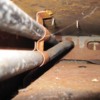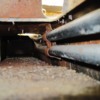Success - the heater tubes have been removed. I almost gave up on attempting this but the local garage owner said he would come over and give me a hand.
Tools needed: Hammer, chisel(a really long chisel), Sawzall. Working through the rear tunnel opening under the firewall and the opening behind the shifter, with hammer and chisel, split open the front bracket and open the back bracket to the point where you can move the tubes back and forth. The tubes aren't tack welded but the brackets are. Working through the shifter box opening, firmly hold the tubes and cut through them with the Sawzall. Now the tubes can easily be removed. Chisel off the two brackets if they're still attached.
This went a lot easier than I was expecting and it took about 30 minutes to do. I have a lift and raising the car made it a little easier to see into and work through the rear tunnel opening under the firewall. Of course, this job can only be done with the engine removed.
Below is a photo of the old tubes. They are pretty sturdy and may have nver leaked. But they are full of a slimey black crud and I didn't want that going through my system. I'm glad that I decided to do this.
Dennis
Attachments
Original Post



